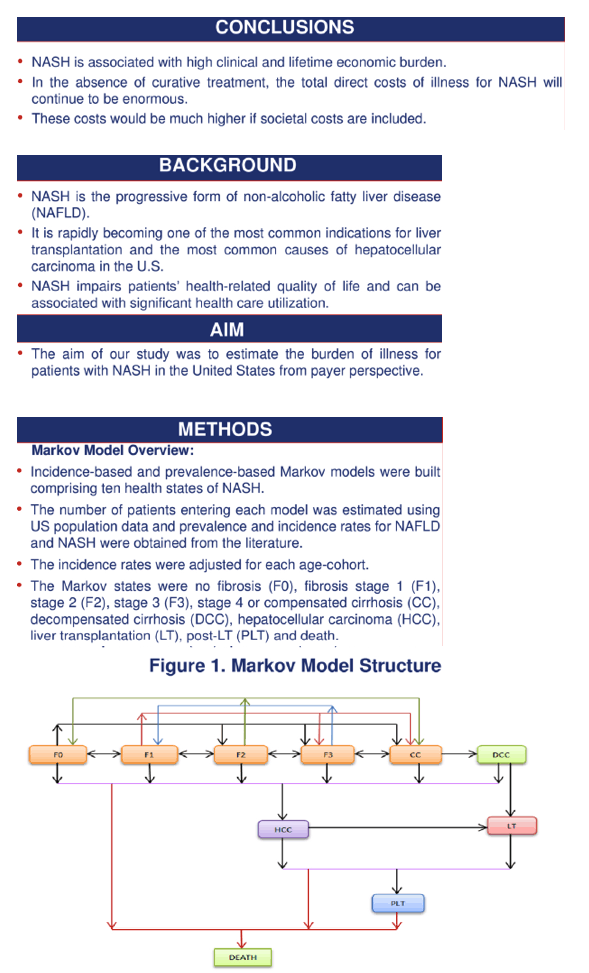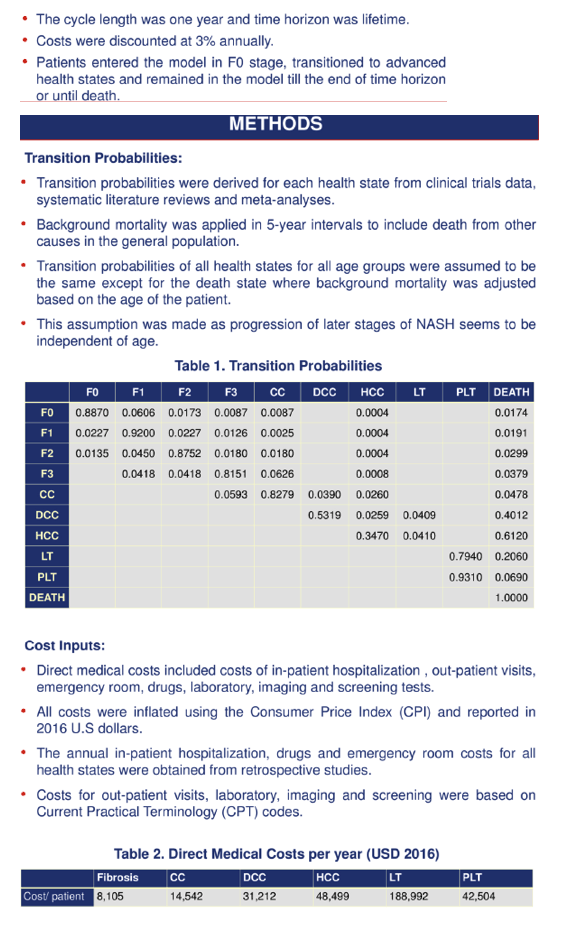| |
Burden of Illness Economic Model for Patients
with Non-alcoholic Steatohepatitis (NASH) in
the United States
|
| |
| |
Reported by Jules Levin
AASLD 2017 Oct 20-24 Wash DC
Zobair M. Younossi2,1, Masoom Priyadarshini2, Mariam Afendy2, Fatema Nader3, Issah Younossi3, Andrei Racila2,3, Maria Stepanova3; 1Center for Liver Diseases,
Department of Medicine, Inova Fairfax Hospital, Falls Church, VA; 2Betty and Guy Beatty Center for Integrated Research, Inova Health System, Falls Church, VA; 3Center for Outcomes Research in Liver Diseases, Washington, DC
Program ABSTRACT
BACKGROUND:NASH is the progressive form of non-alcoholic fatty liver disease (NAFLD). Given the paucity of economic data regarding NASH, our aim was to use a Markov model to estimate the total burden of NASH in the U.S.
METHODS: We used the payer perspective to construct lifetime Markov models estimating the economic burden of NASH in the U.S. The incidence-based models comprised of 12 age cohorts (5-year intervals from age 20-24) with different stages of liver disease. Health states included no fibrosis (F0), fibrosis stage 1 (F1), stage 2 (F2), stage 3 (F3), compensated cirrhosis (CC), decompensated cirrhosis (DCC), hepatocellular carcinoma (HCC), liver transplantation (LT) and post-LT (PLT). The number of patients entering each cohort model was estimated using US population data and prevalence and incidence rates for NAFLD and NASH were obtained from the literature. The incidence rates were adjusted for each age-cohort. Transition probabilities between states were derived from meta-analyses and a model using the declining exponential approximation of life expectancy (DEALE) method. Age-adjusted background mortality was incorporated in each model to account for other-causes of death. These probabilities were used to calculate the percentage of patients in each health state per year. Costs included in-patient, out-patient, professional services, emergency department and drug costs, which were obtained from Center for Medicare & Medicaid Services (CMS) Fee Schedule 2016 and published data. All costs were discounted at an annual rate of 3%.
RESULTS: The models estimated that there are 8,667,210 subjects with NASH (20-79years old) in the U.S. The total lifetime cost for each health state by decades of age is summarized in Table 1. The lifetime cost burden of all NASH is $859,339,050,979 and those with NASH>F2 is $193,747,357,985. The projections of costs for each age-specific NASH cohort suggest about 350% increase in the next 5 years.
CONCLUSION: NASH is associated with high lifetime economic burden. In the absence of curative treatment, the total direct costs of illness for NASH will continue to be enormous. These costs would be much higher if societal costs are included.



| |
| |
| |
|
|
|